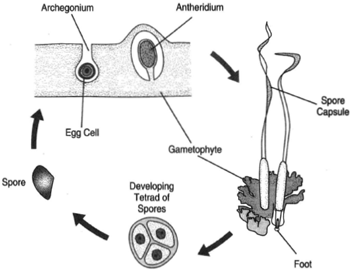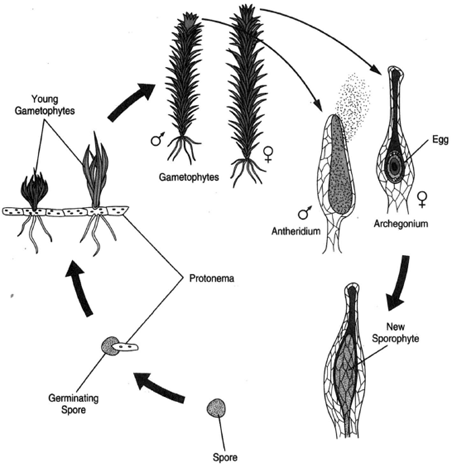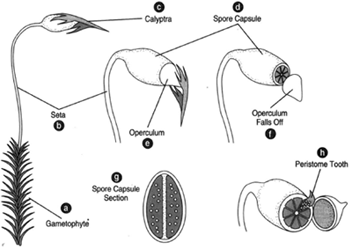Mosses
 |
| Figure 24-4 Anthoceros. At left, an egg cell in the center of the archegonium and to its right an antheridium. At right, the sporophyte generation growing in the remnant of the archegonium. It produces a foot, which grows into gametophyte tissue and may continue into the soil below. |
Mosses are low plants that produce dense mats. They occur mostly in moist places, but some forms can be found in the desert. Approximately 14,500 species have been described. Mosses provide an elegant example of alternation of generations. The gamete-forming generation begins with a meiospore. The meiospore produces a chlorophyll-bearing delicate thread called the protonema, rather than growing directly into the gametophyte. The protonema soon produces rhizoids, which grow down into the soil, and buds, which represent the first cells of the gametophyte plant. As the buds continue to grow, they each produce an elongated leafy stalk at the apex of which the reproductive organs are produced. In Polytrichum, the hairy cap moss, the sexes are separate. The upper end of the female gametophyte bears a cluster of archegonia among paraphyses, and the male plant bears the antheridia. Both antheridia and archegonia are on short stalks. Canal cells in the neck of the archegonium must break down to allow a passageway for sperm cells. Biflagellated sperm cells are released from the antheridium and attracted to the archegonium by chemical substances released there.
The egg cell, being fertilized in the venter of the archegonium, grows into a sporophyte. The sporophyte remains attached to the upper end of the gametophyte. As the sporophyte grows, it produces a foot, which grows downward into the gametophyte tissue, and an elongated seta, which bears the spore capsule at its upper end. The archegonium also continues to grow. As the sporophyte elongates, a portion of the archegonium breaks away and is carried aloft as a cap on the spore capsule. This is called the calyptra, or hairy cap. When the sporophyte matures, the tip of the seta bends, causing the capsule to hang downward. The calyptra then falls off, and the covering of the capsule, called the operculum, breaks away. The operculum is dehiscent: it thus breaks away along specific lines. At this point, the capsule is not yet open to release the spores, however. The peristome, a membrane below the operculum, dehisces along radial lines to produce a circle of membranous points, called the peristome teeth. The hygroscopic points move in and out with changes in humidity and aid in the dispersal of spores. The spores, landing on favorable soil, can then produce protonemata.
 |
| Figure 24-5 Moss gametophyte generation. At left a protonema with the beginnings of two young gametophytes. At center, the male gametophyte is distinguishable from the female gametophyte by the star-shaped expansion of the upper leaves. At right, the egg cell fertilized in the venter of the archegonium grows into a new sporophyte. |
 |
| Figure 24-6 Moss sporophyte generation. (a) The leafy gametophyte. (b) The stalk, or seta, rising up from the gametophyte. (c) The calyptra. The stalk bends, and the calyptra falls away, revealing the spore capsule, (d), capped by the operculum, (e). (f) The operculum falls off. (g) A cross section of the spore capsule revealing a central column of tissue. (h) A head-on view of the spore capsule showing a peristome tooth extended. |




